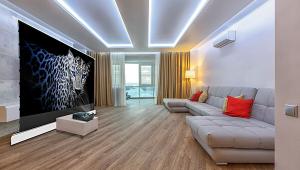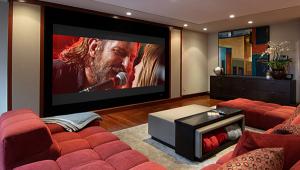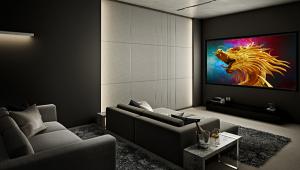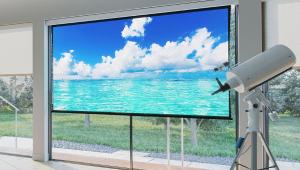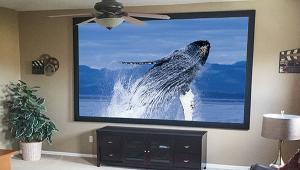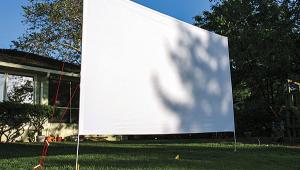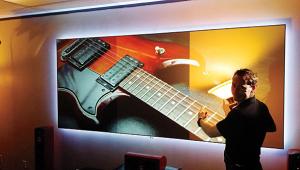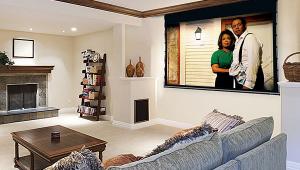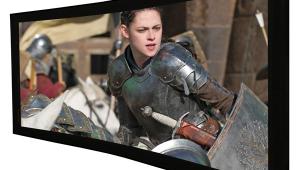Even if a totally Dark room treatment (still, by far, the ideal) is not desired, the color and reflectivity treatment is still critical. Kodak gray is still the best alternative wall treatment. The worst would be canary yellow, as has been featured in past Audio/Video Interiors Magazine issues. For watching a title like Fargo, canary yellow is likely to render snowy opening scene as urine yellow! Color neutrality still counts big time!
Screen Innovations Black Diamond II HD Projection Screen Page 2
Light Up My Room
Driven by a JVC DLA-X3 projector, the Black Diamond succeeded brilliantly. Overhead lighting may slightly compromise its performance, depending on its angle to the screen and the ceiling height. And you can’t use lights that are positioned nearly on axis to the screen, as it can’t distinguish them from the light from the projector. But if the off-axis lighting is sufficient, you’ll see a vivid, crisp, rich image with impressive contrast in what amounts to an ambient light level that would be unsuitable for a normal screen.
One caveat: I wouldn’t recommend using the Black Diamond in a sunlit room with white walls and a white ceiling, such as in an SI promotional photo I saw. But if this describes your situation, the Black Diamond screen is still likely to work better than any other option I can think of. Its benefits varied dramatically with the location and strength of the lighting. In a variety of lighting situations, the Black Diamond was either equal (rarely) or superior (most often) to my resident Stewart Filmscreen StudioTek 130 (1.3 gain). The one situation that was a subjective toss-up was with lights to the side of and behind the screen.
In the photos shown here, a relatively bright table lamp was positioned about 3 feet to the left of the screen and 3 to 4 feet forward of it. The shots slightly exaggerate the visible differences, but they tell the tale more vividly than any written description. The improvement with the Black Diamond is obvious, either in split-screen form (Photo 1, above) or full-screen shots of the same image. (Photo 2 is the StudioTek, and Photo 3 the Black Diamond—in case you haven’t already figured that out).

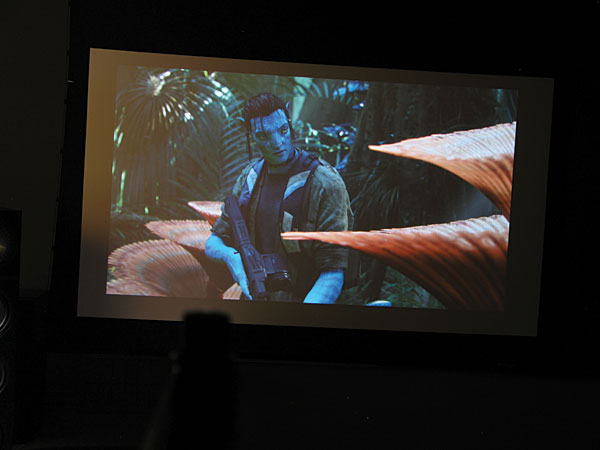

Darkness Falls
Despite the emphasis in this review on the Black Diamond’s performance with the lights on, I’m big on watching movies in the dark. The darker the surroundings, the more easily a good film can draw me in.
But even in a darkened room, light from the picture can cause reflections back onto the screen. The less of this there is, the better the overall contrast. My room has reasonably subdued boundary reflections but is far from a black hole. Still, with my room totally darkened, the Black Diamond dramatically decreased these reflections compared with the StudioTek 130. The picture had superior punch, and black bars on widescreen images nearly disappeared. Initially, I found this compelling; the Black Diamond in a darkened room suggested the coming of an 80-inch Pioneer KURO.
But the same mechanisms that limit the Black Diamond’s rejection of room light also limit its ability to spread the light from the image toward a viewer seated off to the side. When I sat about 30 degrees off axis, I noticed that the screen brightness wasn’t as uniform as it was from the StudioTek. It turned progressively darker on the side of the screen furthest from me. The difference wasn’t dramatic, but it wasn’t hard to spot on the right material. I also noticed a small color shift on the Black Diamond with the image optimally calibrated for each screen. This was most evident in fleshtones and possibly the result of a subtly worse color gamut (which the JVC DLA-X3 cannot correct for through its factory-supplied adjustments).
Conclusion
It’s unrealistic to expect superb results from the Black Diamond in a room flooded with bright sunlight. No projector and screen can do that. But with discreetly positioned lighting sufficient for eating, conversing easily with others, and even multitasking (we used to call that reading), the Black Diamond will get the job done better than any other screen I know of. Yes, a more conventional screen will serve better if you do most of your watching in the dark. But if you can’t manage that, the Black Diamond will make a projection system a real option for those who would never consider one before.

Note: The Where to Buy link below is an affiliate link. If you purchase through the link, we may earn a small commission at no extra cost to you. Thank you for your support!
- Log in or register to post comments


*Initially, I found this compelling; the Black Diamond in a darkened room suggested the coming of an 80-inch Pioneer KURO.
*Yes, a more conventional screen will serve better if you do most of your watching in the dark.
OK,I'm confused about your comments above. First, you state that in a darkened room it suggests the coming of an 80 in Pioneer Kuro, but yet you state that a conventional screen will be better watching in the dark. So will a conventional screen also rival and Kuro with your projector?
Can you elaborate on this? I too have a room with similar specs as yours but is totally light controlled. Im thinking of getting a Black Diamond but I now question if that's a good idea since I watch most of my movies in the dark. Is there a better screen for light controlled environments?
Thanks

The screen fastens to the frame with small bungees that slip through holes in the edge of the stiff screen material and attach to small plastic posts on the back of the frame.
